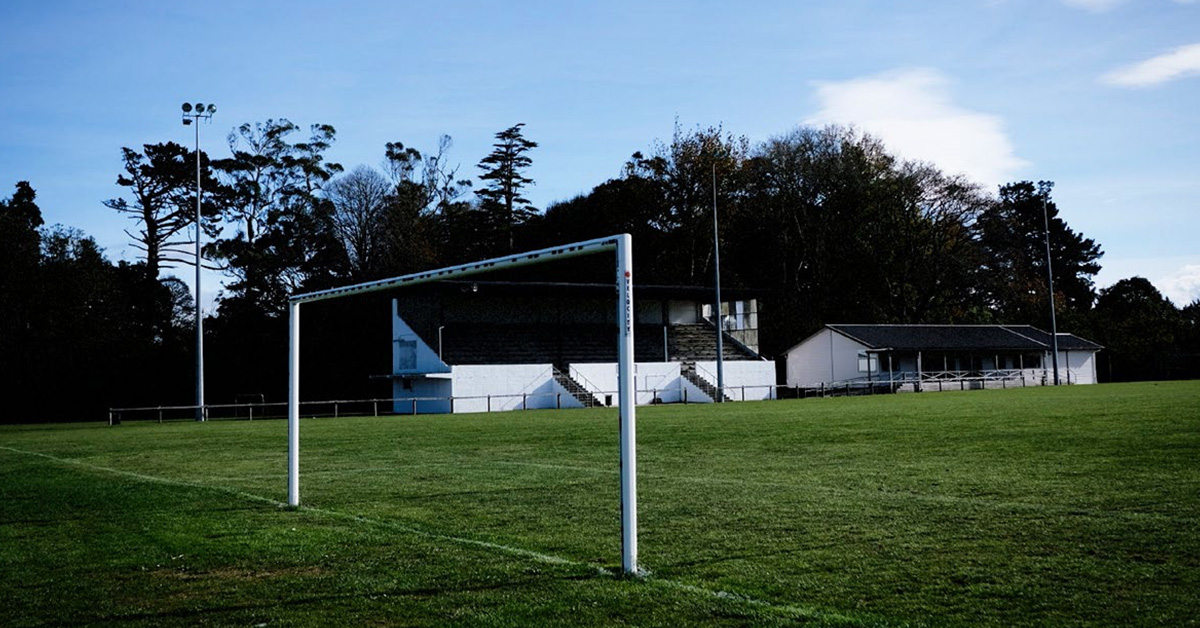
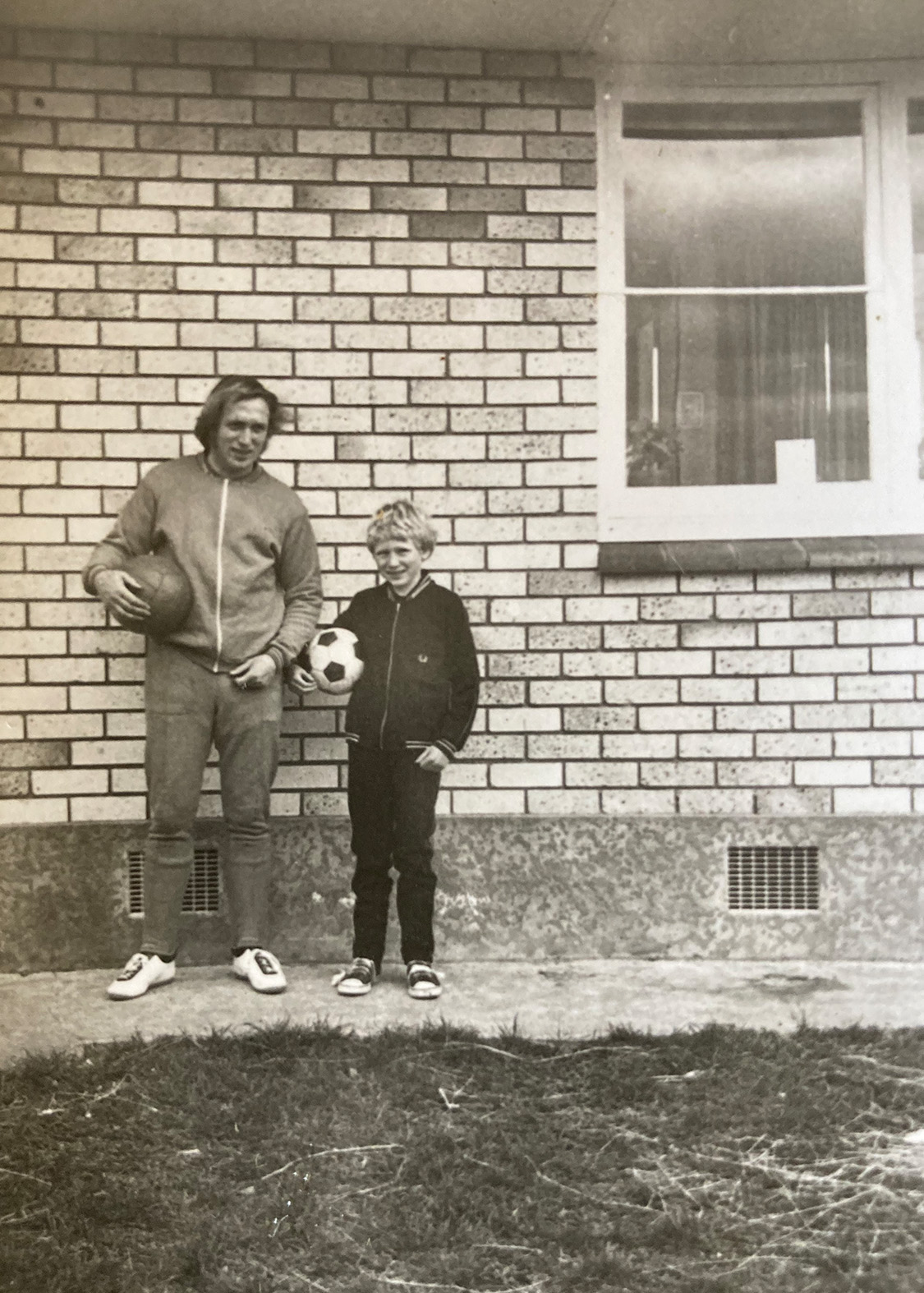
A Quiet Revolution
Once were champions: for well over a century, Eltham’s rugby club packed out grounds and clubrooms and brought home silverware. Now soccer posts dot the town’s playing fields. Tim Higham returns to his home turf to find out what’s behind the code swap.
Photo: David and Tim Higham before a game in Stratford.
My first game of team sport was rugby, for Eltham Rugby Football Club 13th Grade White. We mostly eight-year-olds had been to weigh-ins and played barefoot on the frosty fields below Eltham Primary School. Our rivals were 13th Grade Black. Rugby meant running around in a pack after Gordon Ngatai, or Mark Cameron in the case of Black, yelling at them to pass the ball.
That year — 1971 — Eltham’s rugby club fielded at least one team in most weight grades, from Senior A to the 13th grade. All the town’s fields were full, and the big games were on the home ground at Taumata Park.
Through the 1950s four to five thousand spectators would turn up to the park, and fill nearby clubrooms afterwards, as the club took out the provincial championships five times. In the late 60s, they came to watch All Black prop and local freezing worker Brian “Jazz” Muller. The club’s centennial publication in 1998 traced affiliations through generations of Eltham rugby families, some producing 10 senior players apiece.
My father, David Higham, arrived in Eltham in 1969 with a young family to join Eltham Veterinary Services, a club practice owned by the dairy farmers of the area, on a three-year contract.
He was handy at association football (or soccer as it was referred to in New Zealand at the time) and cricket, having captained the first elevens of both codes while at Woodhouse Grammar, near Sheffield, and the University of Bristol. He and my mother Margaret, a fierce tennis and hockey player, were the first generation in their families to gain a tertiary education and escape their pit towns.
Dad joined other immigrants keen on soccer and played in the nearest senior men’s football team, in Stratford, 11 kilometres away. He slowed the game down, held possession in midfield, and directed the game in a South Yorkshire accent. Calls for the ball or warnings of “man on” carried brogues from across England, Ireland, Scotland and the Netherlands — farmers, tradesmen and a cohort of teachers from Stratford High School, many who’d arrived as “10 pound Poms” under the Assisted Passage Migration Scheme.
My friend Piet de Jong, son of Eltham head vet Hendrick (Hank), and I heaped grass into piles to throw into the air when Stratford scored and climbed into the hedges surrounding the Portia Street ground for vantage points. When the team went to the County Hotel for after-match drinks, we happily play-fought across the bench seats of the Ford Falcon station wagon for hours, bribed with a big bottle of Leed lemonade and hot dogs and chips.
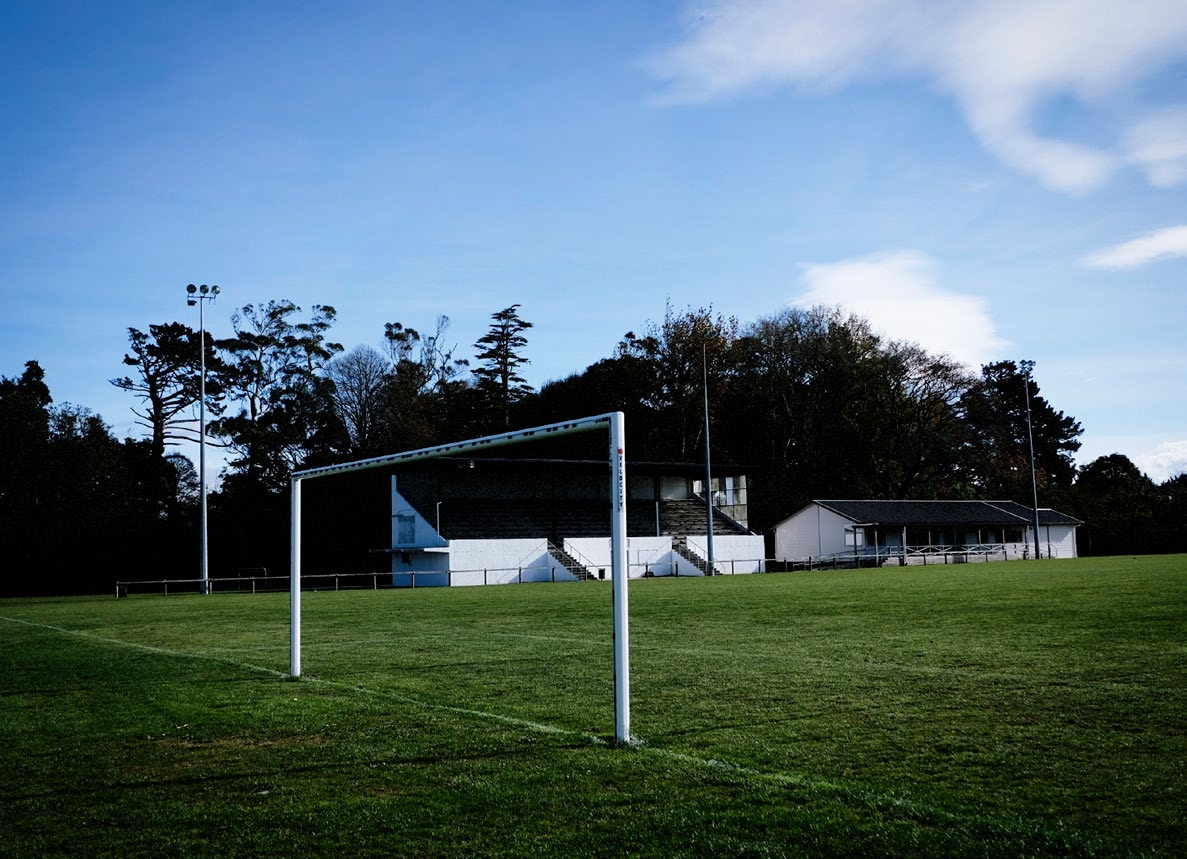
Eltham’s Taumata Park was a rugby setting until soccer took over the ground in 2014. Photo: Tony Reddrop.
I’m revisiting Eltham, taking a photo through the wrought-iron gates of Taumata Park to show truncated goalposts on the main field rather than the H shaped ones familiar from my childhood.
There’s a groundsman on the side field marking out white lines and I walk towards him thinking it will make another good photo.
“That’s the spot,” he says as I approach, pointing to a box he’s just marked out around the posts at the grandstand end.
It takes me a few seconds to work out that the line marker is Val Mekalick. He was on this pitch with me in a team of mainly 10-year-olds in the newly formed Eltham Association Football Club. As I slid in to knock the ball between the posts, the opposition goalkeeper rushed out boot first and knee locked straight. Mekalick heard my tibia and fibula snap to dangle loosely in a sleeve of skin.
My dad, who was refereeing the soccer match, pulled my right leg straight, adding damage to severed nerves and blood vessels, and the game was abandoned.
I lay on Taumata Park for the next hour waiting for an ambulance to arrive from Stratford, with a sense that my life had just changed.
As well as line marker, Val Mekalick is a life member of the Eltham AFC, its secretary, and coach of the women’s team.
Mekalick is a Moravian name, but Val’s family came to New Zealand three generations ago. He was one of the few Kiwi kids to sign up when the new club was formed, getting a ribbing for “being a soccer sissy”. His best mate Ian Stanners — now club patron and another stalwart — had brought a round ball to school “and it was a lot of fun”.
Mekalick shows me underneath the concrete war memorial grandstand at Taumata Park. Opened in 1957 to seat 650 rugby fans, it replaced the original wooden stand from 1905. Now, there’s a ref’s room, women’s room, communal showers and a room for the visiting soccer team. The home changing room has a designated spot for each senior team player with a colour photo of them in action and a clothes hanger for their game day kit.
Calls for the ball or warnings of “man on” carried brogues from across England, Ireland, Scotland and the Netherlands
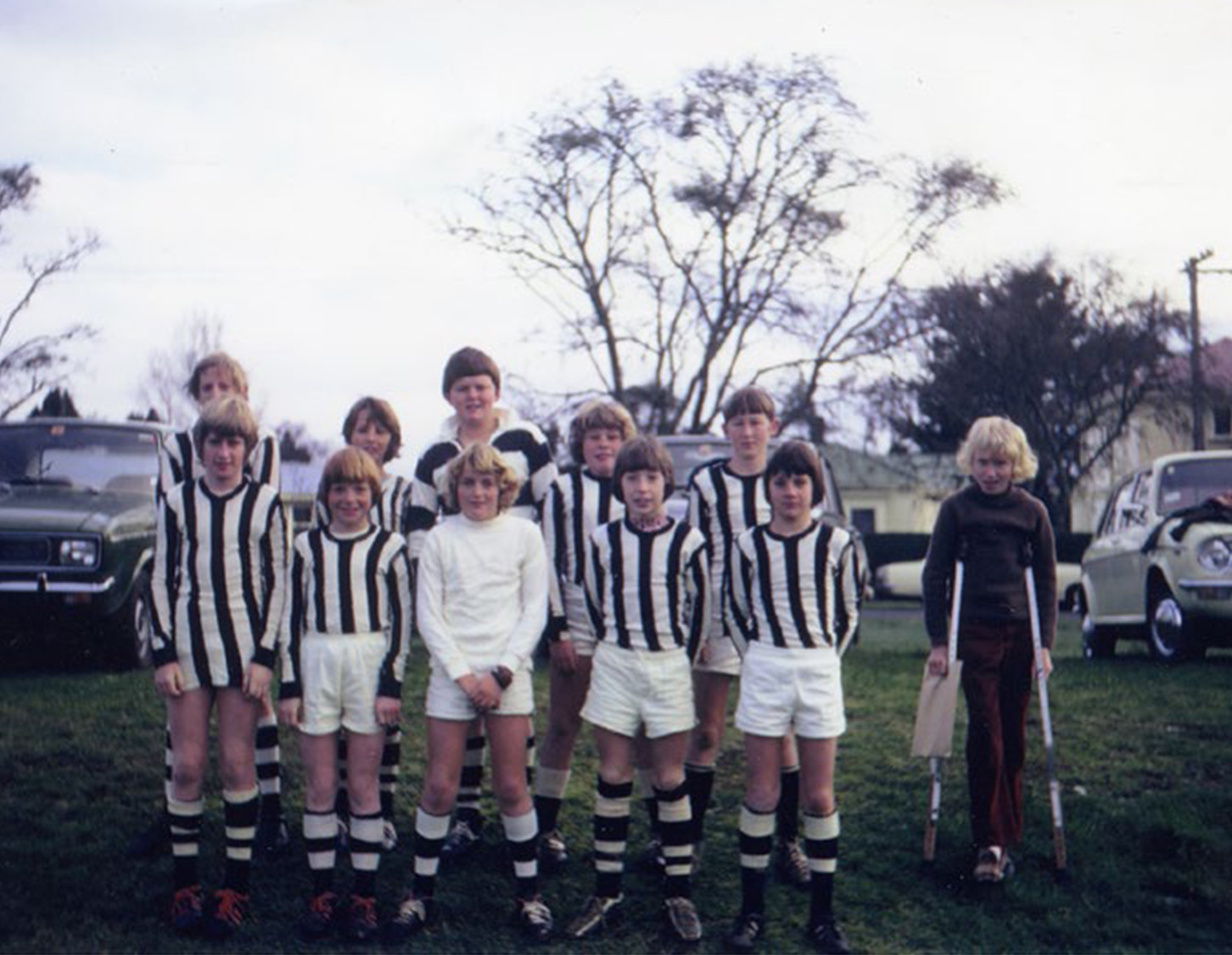
Tim Higham (on crutches) with Val Mekalick second from right, front row, and Piet de Jong back row second left.
Next to the grandstand is a new community recreation centre, a shared facility used by the club, with a heat pump, stackable tables and chairs for several hundred guests, a commercial kitchen, bar and a club sponsors board. The annual prizegiving is held there and “even the flash city clubs are impressed with our after-match facilities,” says Mekalick.
I spot, propped in the corner of the grandstand changing room, a reminder of more humble club beginnings, a lichen-covered routed sign saying “Taylor Park”.
Mekalick loans me a red, broken-spined Warwick minute book. It records that the inaugural meeting of the Eltham Association Football Club was held on 1 April 1974 at 7.30pm at the veterinary clinic. President of the Taranaki Football Association Mr A Imrie welcomed the 28 people present and Mr D Higham (my father) was duly elected president.
Dad then reported to the meeting that two new pitches — a full-size field and a junior one — had just been bulldozed and formed on the Taylor Reserve; low-lying ground on the opposite side of town from Taumata Park. All improvements had been done “on a voluntary basis” and a “donation of $425 by the Government Dept. of Sport & Recreation had not been spent”
He said there were not yet enough senior players to enter a team in the Taranaki Football Association competition but next season, coinciding with the new grounds, he hoped there would be a senior team.
Inaugural club secretary Roy Sproule, a non-playing Irish vet, remembers that Eltham mayor Red Bourke “replied in a less than enthusiastic manner when we mooted the idea of having our own pitch — ‘This is a rugby town’ was the answer. However, he did offer the services of Laurie Booker, who worked fulltime for the council. Laurie enthusiastically set to with the bulldozer and we had our two pitches, albeit complete with the swamp.”
Eltham’s centenary book of 1984 records the grounds at the FJ Taylor Reserve, provided by the Eltham Borough Council, were officially opened on 1 April 1975, another Fools’ Day.
The senior team with player-coach David Higham entered the competition. Eighteen games were played that year, with eight wins, eight losses and two draws.
The minute book reveals drainage was an ongoing issue — the ball always stopped dead along the Graham Street touch line under a stand of poplars. Many car washes, sausage sizzles and mystery envelope fund-raisers were held and after frustrating delays, painstakingly reported by the building sub-committee, galvanised-iron-clad clubrooms were built on the reserve. Over time the home ground became known affectionately as “the swamp and the shack”.
In 1983 the club fielded 115 junior players, giving Eltham the largest membership in the Egmont Junior Football Association. “We struggled for a while, not through lack of enthusiastic players, but more because the nuts and bolts of running the club fell on the shoulders of too few,” recalls Roy Sproule. “I felt the turning point came when a group of ladies, mums, wanted to form a ladies’ team. Their contribution behind the scenes was enormous.”
The Eltham men’s side has never claimed the Taranaki Premiership, but it’s won the Duff Rosebowl (a league knockout competition like the FA Cup) twice and the Federation Cup, a wider regional knockout tournament among central North Island clubs. It’s also won division one, division two and the lower leagues.
The club also produced Dianne Wyss in the late 70s– early 80s, a fierce tackler, regularly picked for Taranaki rep duties and, one year, as non-travelling reserve for the New Zealand women’s national football team.
I played only one game in the same team as my father on Taylor Reserve. I was well off the pace — a legacy of the junior grade broken leg — but managed to toe-poke a goal with a striker’s sense of getting in the right position. It was a bucket-list day for my dad, who after that refereed more games than he played.
Today a doggie doo bag dispenser fronts the boarded-up tin shed within an off-leash dog exercise area.
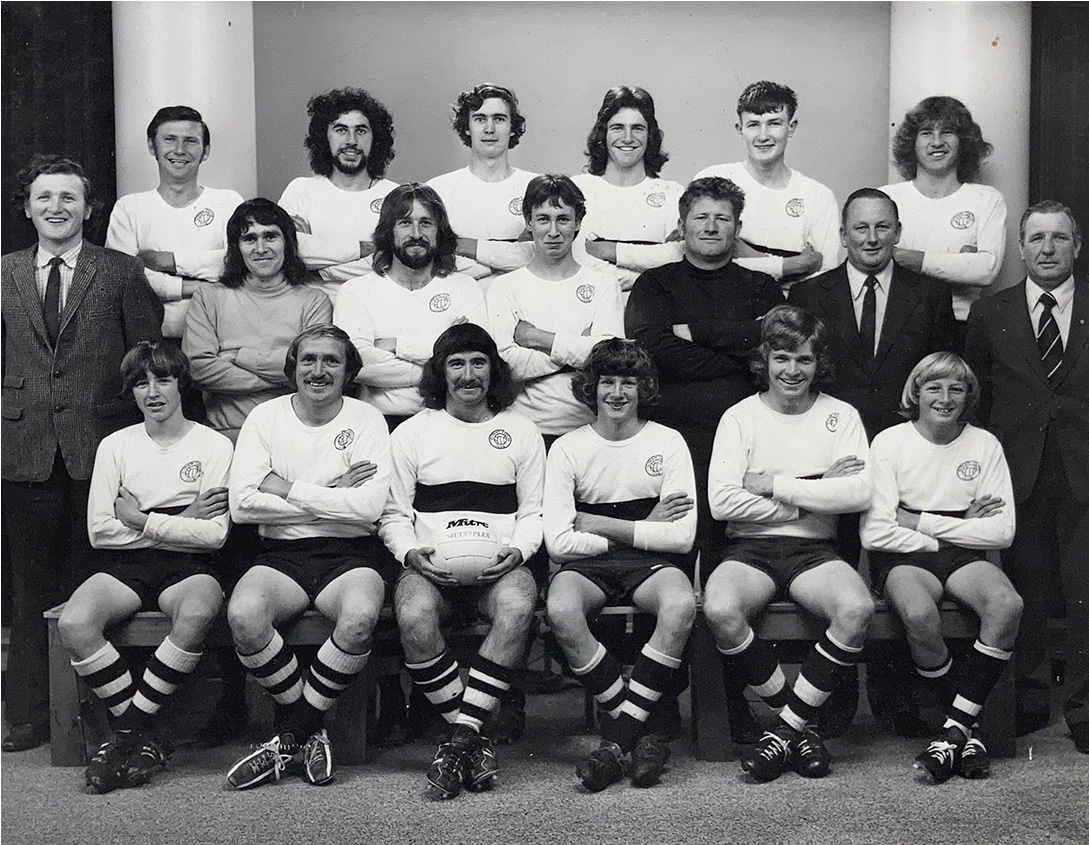
David Higham (left of ball holder) in Eltham Association Football Club’s first senior team in 1975.
In my teens I code-hopped back to rugby. The social prospects for a footballer seemed bleak and, every other year, Stratford High School First XV went on an overseas trip. My goals were a girlfriend and Fiji.
I made the Second XV in my sixth-form year playing second five-eighth with safe hands for distribution and a football-inspired grubber kick behind the line. Enough to make the school First XV the following year as utility back.
I played fullback in an inter-school game and made a head-on crunching cover tackle on a big-thighed Hawera winger with the whole school watching from the touchlines. That won me a couple of dates.
Names from that side — Dave Gallagher, the Eltham schoolteacher’s son and a hard-working rangy flanker, and Pete Shearer, a Mangatoki farmboy and speedster — went on to be part of the squad that created the second golden era for Eltham rugby, from the mid-80s.
Rawiri (Ra) Mako was a tricky hal!ack whose father worked for a Stratford engineering company and rented a farmhouse up the road in Ngaere. Mark “Jazz” Muller, a Mangatoki farmboy back from boarding at St Patrick’s College, Silverstream, was a hooker nicknamed after his All Black uncle, Brian “Jazz” Muller. They were respectively captain and vice-captain of the Eltham Senior A side which lifted the Taranaki Premiership in 1990 and 1991. Both played more than 200 games for the club — and put in hundreds of hours each marking lines on pitches.
Mako says the Senior A team was built around a group of players of similar age and skills. He and Muller were both at the freezing works with many of the other members of the squad. “We worked together, played together, drank together.” Half a dozen made the Taranaki representative side, including Mako (4 caps), Muller (42 caps) and line-out jumper and hard man Jamie Connell, one time goalkeeper for the Eltham soccer club.
“The most incredible moment of my life was getting off the bus and walking into the Eltham clubrooms after we’d won the trophy.”
Jock Richards was the rugby coach and he brought in changes. Women were allowed on the bus. You got a blazer if you made the seniors (later changed to 10 games for budget reasons). No drinking on a Friday night. A leadership group was formed from the senior players. “He made us believe in ourselves,” Mark Muller says.
In 1989 Barry Robertson took over, a dentist who’d been a major in the army “and was great with people,” says Mako. He dropped long-serving prop John “Chopper” Turahui, on the basis that a side is only as fast as its slowest player, a move that prompted the side’s All Black, Bryce Robins, to move to rival club Clifton for a season in protest.
Robertson brought in Jim Blair, an All Black coach who introduced “plyometrics”, repetitive strength conditioning work which included “lots of jumping on one leg”, burpees and box jumps. “The players hated it,” says Muller, but their improved fitness enabled them to power past teams in the last 20 minutes.
The whole town got behind the side again. Busloads followed them to away games When they played arch-rivals Inglewood (with All Black Dave Loveridge behind the scrum), “It felt like there were 10,000 people there,” says Mako. Muller says, “The most incredible moment of my life was getting off the bus and walking into the Eltham clubrooms after we’d won the trophy.
“My parents were there, my grandparents, the place was packed, there was cheering, fist pumping. After years of trying for the town . . . the emotion of it. That 10-year period was the most exciting time of my life. I wouldn’t change a thing.”
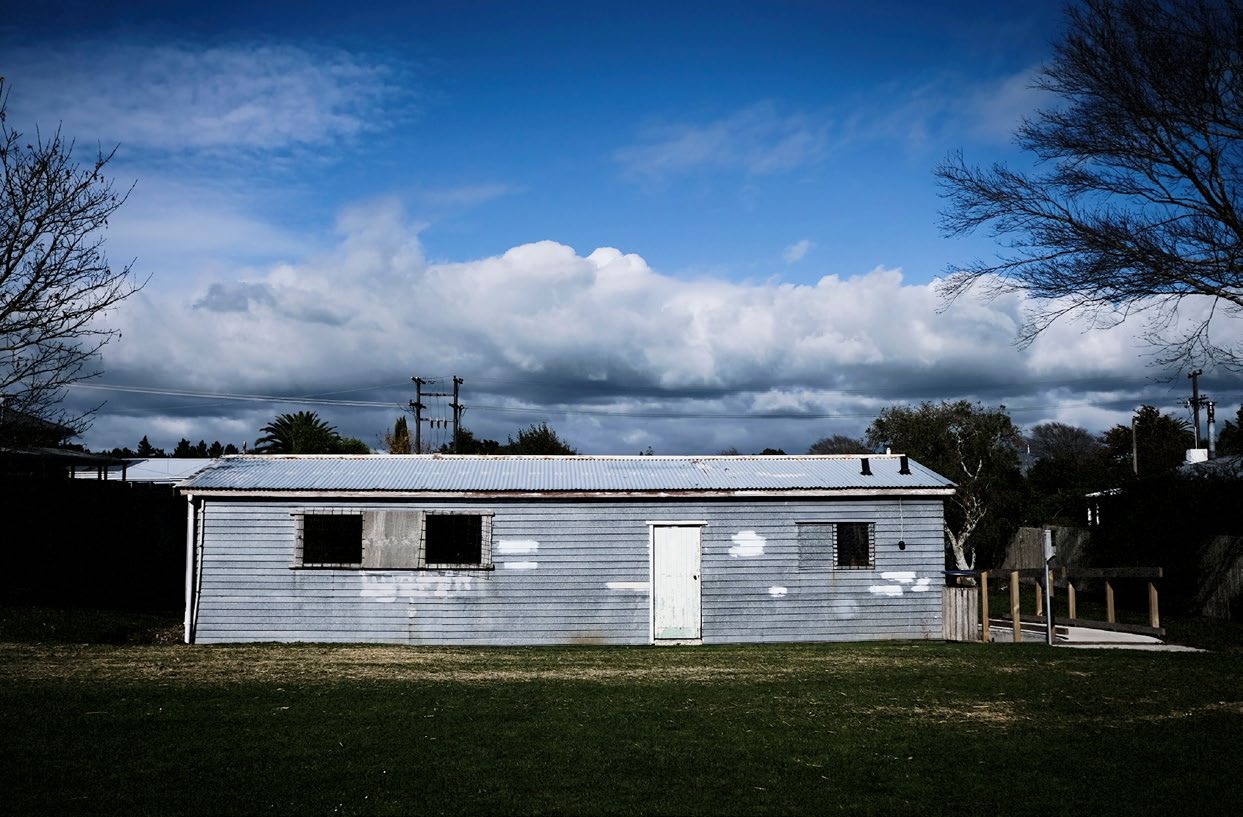
The galvanised iron shed that served as soccer clubrooms on the swampy Taylor Reserve. “This is a rugby town,” the town’s mayor remarked when the grounds were first mooted. Photo: Tony Reddrop.
Today the Eltham rugby’s clubrooms lie abandoned by the railway lines, across from Fonterra’s Collingwood St cheese factory and, behind that, Taumata Park with its soccer goalposts.
If you want to watch rugby in Eltham today it would have to be a boys or girls side associated with the primary school. So, what happened?
Ra Mako is human resources and environmental manager for the ANZCO Foods meat processing factory (formerly JC Hutton Ltd), a few twists of the Waingongoro River downstream from Taumata Park.
He attributes the change in rugby’s fortunes to the Employments Contract Act of 1991. “Then everyone who worked in the town lived in the town. An A-grade boner could earn a thousand dollars a week, the same as a doctor.”
Overnight, employees could choose to work under either an individual or collective employment contract. Bargaining over contracts and disputes was entirely voluntary. “It was sold as an opportunity to earn more money, but A-grade boners are still earning a thousand dollars a week,” says Mako. Two shifts were introduced at the plant and workers encouraged to work ‘four on, four off’. “People think they will have four days off, but it doesn’t work like that.”
It was a period of bitter industrial disputes. In 1996 my younger brother Michael was among 100 strikebreaking workers bused into the plant and pelted with eggs by picketers.
My dad, then the head vet at Eltham Veterinary Services, often moonlighted as a meat vet at the works, in anticipation of retiring at 60. He enjoyed mixing with the men on the killing floor, knowing most of them from the local sports clubs.
But soon Eltham was struggling to put a rugby team together. Not enough men could attend practices or reliably turn out on a Saturday. The camaraderie at the freezing works had been disrupted. Some of the boys joined the burgeoning oil exploration industry. It was more money and they worked “two on, two off”.
To enter the Taranaki Premiership a club also needed to field a Senior B side. In 1998 the club combined with Kaponga — a smaller club 13 kilometres west — to make up the two teams, but splitting home games meant there would be only three appearances a year on Taumata Park.
The writing was on the wall.
I’m curious to find out about who forced the changing of the goalposts. Did an upstart soccer club — then fielding three senior men’s teams and a women’s team — lobby the South Taranaki District Council and suggest they might make better use of ratepayer-funded facilities?
Val Mekalick is circumspect. There was an incident in Hāwera when his son Mark, a senior side player at the time, found himself pushed up against the side of a bar accused by a rugby player of “trying to take our ground”.
“I was bitter about it then — they were just going to walk in and take over our ground — but I’m not bitter now. It’s ended up been a blessing for us.”
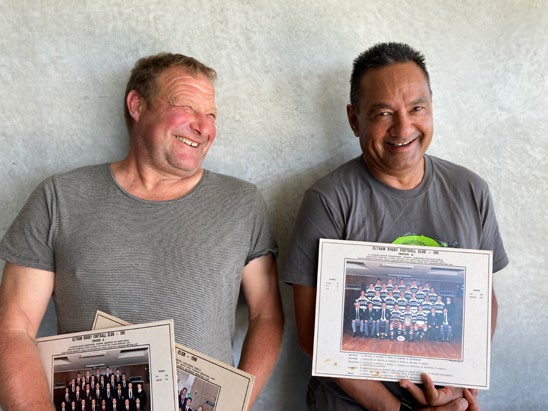
Mark Muller and Ra Mako, captains of Eltham’s rugby premiership winning sides of 1990 and 1991. Photo: Courtesy of the writer.
Tensions were high and the two codes were invited to appear before the council, with an audience dominated by rugby supporters. They argued their fundraising had helped put in the floodlights at Taumata Park and they threatened to take them down. They had history on their side and wanted a stay of execution.
But when I talk to former councillor Gordon Lawson, a long-serving Eltham town clerk from the time the Taylor Reserve fields were created, he several times refers to the decision to switch grounds as “logical”.
On 24 February 2014, the South Taranaki District Council voted 9–3 to shift the goalposts.
Eltham Rugby Football Club would use Soldiers’ Memorial Park, aka “Snake Gully”, for their three home games, and floodlights could be installed for training. Eltham Association Football Club would have not just Taumata Park but also neighbouring Saunders Park, once home to the town’s hockey club.
“It was a stitch up,” says Ra Mako. “I was bitter about it then — they were just going to walk in and take over our ground — but I’m not bitter now. It’s ended up been a blessing for us.”
After a couple of years of reasonable success with Kaponga, using porta-showers, changing rooms and toilets at the nearby public swimming baths in Snake Gully, the combined clubs increasingly struggled to put together a second team. The Eltham clubrooms were empty after a match and closed by 5.30pm.
The combined clubs’ first team dropped down to division one and Eltham began to look elsewhere for its future.
Stratford had clubrooms, a good committee structure and loyal supporters but its Senior A side had won only two games in six years. After an on-again off-again courtship, the once rival clubs agreed terms and the Stratford Eltham Rugby and Sports Club formed in 2017, its crest combining the traditional red and black stripes of Stratford with the black and white ones of its southern neighbour.
With Mako installed as head coach, the senior team won five games in their first season together, seven after that and “are improving year on year”. A thousand people now show up for home games at Stratford’s Victoria Park, $15,000 was taken over the bar at the clubrooms after a recent match, and the town’s netball team adds to the talent in the new sports club arrangement.
Both towns’ rugby histories are celebrated in the club’s memorabilia room. It records that during its 129- year history Eltham Rugby Football Club produced four All Blacks: Francis Glasgow 1903–05, Roger Urbahn 1959–60, Brian “Jazz” Muller 1967–71 and Bryce Robins 1985.
Piet de Jong, my friend from watching Dad’s games in the 1970s, looked at the place of rugby in Eltham as part of his sociology thesis at Massey University. At the time he described it “as the history of rugby from a Marxist perspective”, motivated by the social divisions exposed by the 1981 Springbok tour.
A book resulting from his thesis, Saturday’s Warriors: The Building of a Rugby Stronghold, was published a decade later.
Piet writes in the book about a march in Eltham, where the protesters were a dozen local teachers and ministers, and a few university students in support.
“As the protesters turned left into the main street, they saw what they were in for.” He cites Geoff Chapple’s book 1981: The Tour, “The footpaths were packed, people spilling out onto the road. Cars with families hanging out of them . . . never seen the town so full . . . they [the protestors] felt the whole town hunched over them, and it wanted to snuff that small flame.”
Piet continues: “A small hard-core of rugby supporters, armed with eggs and flour, bombed the protestors from the top of Morton’s Buildings. The large crowd jeered, jostled and booed the protesters, aghast at the apparition of an actual protest march in Eltham’s main street.”
“One Eltham man showed a flawed political perception but superb language skills when he yelled at a woman protestor: ‘Why don’t you fuck off back to Russia, you, red, fascist, commie, hippie bitch.’”
Piet’s thesis interviews conducted with old timers, some in the Eventide Home on the hill overlooking the town, revealed the important social bonds and town pride created by playing for the club.
I ask Piet — now a partner in a leading Auckland public relations firm — what he makes of his “Marxist” thesis today.
“Within the strictures of class, empire, war, race and masculinity, which are all linked, the men carved out a rich space of rituals where their sacrifice, courage and mateship were expressed every week of winter by being ‘Saturday’s warriors,” he replies by email. “Egalitarianism ruled — but it was very much a social contract that buttressed the existing economic system and the physical rigours of farming and the freezing works.”
Things have changed in Eltham. The pub that rugby star and All Black Bryce Robins once owned, the Central Tavern, has closed, as has the Railway Hotel. Only the Coronation remains. It sits in the centre of Bridge St. When I grew up there, it was lined with sports shops, clothes shops, chemist, butcher, appliance store, photographer, greengrocer, tea rooms, banks, post office and more.
Eltham presents itself as a “town of firsts”. First refrigerated export butter shipped to England (1885) by Chinese merchant Chew Chong. First butter factory (Chew Chong’s in 1887), which developed the classic pound of butter. First dairy company formed on the cooperative basis (1892). First World Axemen’s Carnival (1901). First meeting of the Taranaki Farmers’ Mutual Fire Insurance Association (1904), a pioneering insurance company. First tarsealed road (Bridge Street in 1906), along with the first concrete power poles. First milking machine (the Gane) in 1909. First reinforced concrete building (The Argus newspaper office in 1910). First sewerage system with a containment tank (1918, alongside Soldiers’ Memorial Park). First rennet production at commercial scale in 1919 (Patea developed the process). First commercial bakehouse in 1928 (now the squash courts). First trials of blue vein cheese (1952). First spray milk powder plant at Collingwood Street (in 1965–66 after Taranaki Co-op Dairy Co Ltd was formed by the merger of Eltham, Normanby, Stratford and Cardiff dairy factories). First rotary milking shed by Hotter Engineering for farmer Merv Hicks (1969). When the Higham family arrived late that year from England, Eltham was in its heyday.
Today, along one block of Bridge Street — from the old Bank of New Zealand building to the Coronation Hotel, behind the original verandah-fronted shops — are the offices and workshops of Carac Group, manufacturing engineers and patent holders for 32 inventions including trailer couplings and track grips for dozers and diggers, exported around the world. Its founder John Burling, ‘JB’, repaired my first motorbike in a shed out the back of Hotter Motors in the 70s.
When my younger brother Michael died in a car crash in 1999, I went to see JB and he welded a metal frame for a memorial plaque we placed near the 18th green on Eltham Golf Course, where Michael used to play to a single-figure handicap.
It’s one of the few other clubs that have hung on in the town. There’s the squash club (also established by my father) in the old bakehouse behind the Bridge Street shops; athletics, which shares the new Taumata Park facilities, small-bore rifle shooting, and basketball. Tennis, bowls, hockey and cricket are long gone.
Eltham is still an industrial powerhouse, with the ANZCO meat plant and Fonterra cheese factories on Collingwood and Bridge streets, and AFFCO’s rennet factory on London St. ANZCO now runs a day and night killing chain and Fonterra has three shifts every 24 hours at its Collingwood Street plant.
But 1500 workers, around three-quarters of the town’s workforce, commute in from around Taranaki or further afield each day.
“I’m a Tarata rugby girl, my father coached Inglewood. I nearly cried when Jake said he wanted to play soccer.”
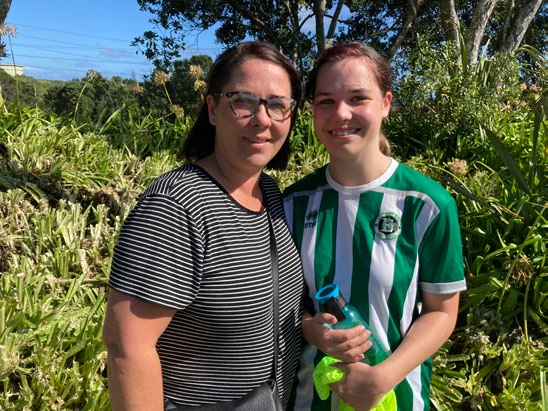
Tamsin and Sienna Dobson are among a minority of Eltham Association Football Club supporters and players who live in the town.
Val Mekalick, who has worked at Stanners Motors (the longest-running family-owned Ford garage in New Zealand) for over 30 years, says he no longer recognises most of its customers. He lives in Hāwera.
Ra Mako, who lives in Stratford, mentally pictures his colleagues in the ANZCO meat plant office and runs through where they live: “Inglewood, New Plymouth, Midhurst, Hawera, Hawera, Stratford, Eltham, Eltham, Stratford, Stratford, Stratford, Whanganui, New Plymouth.”
And there have been changes on the farm. Mark Muller and wife Jacqui, who grew up in Eltham, retired recently to an 8-hectare block above Bell Block near New Plymouth with a new concrete-and-cedar architecturally designed home, belted Galloway cattle, show jumping horses and expansive views of the coast. The family Mangatoki farm, halfway between Eltham and Kaponga, which he took over from his parents in 1985, has more than doubled in size and milks 540 cows, helped by winter grazing on a runoff.
In 2015 when Mark and Jacqui were judged supreme winners in the Taranaki Ballance Farm Environment Awards, they gifted the prize money as a university scholarship for Ra Mako’s daughter Alana, who has since graduated in resource management and environmental planning. The Muller’s own daughter Ellie is now the fourth generation of the family to own the farm with husband Kirk Myers, helped by a manager and two farm workers.
Many surrounding dairy farms employ migrant workers, from the Philippines, India and other countries, unfamiliar with rugby or soccer.
The Fonterra-owned Farm Source rural supply store (formerly RD1) moved from the centre of Eltham a few years ago to a new hub just south of Stratford.
Eltham has the same resident population of just over 2000 since I lived there through the 70s, when its last subdivisions, Chartwell Drive and Willowbrook, were completed. It’s become a commuter town among many former rural service towns across Taranaki.
Running a successful sports club when you’re competing for players across the region takes nous. Most live elsewhere.
While in New Plymouth I watch the Bullitt Fabrications Eltham Women’s football team play Moturoa. It’s early in the season and the competition is yet to split into A and B grades. They lose 15–0. But heads are high and there’s no slacking until the final whistle.
Captain Beth-el Zehnder (n e Oliver) grew up over the fence from the Taylor Reserve. She now lives in Stratford and works in Hāwera as a nurse. Eltham is a family-friendly soccer club, Zehnder says. There are three mother-daughter combos and two sister combos in the side. They’re deliberate about making new players welcome and having fun.
The club has a zero fees policy for juniors up to 15 years, typically $60 elsewhere, subsidising this through fundraising. They do The Warehouse stocktake, recently organised a Lego display at the Taumata Park clubroom ($600 raised), run raffles, manage sponsorships, and apply for grants.
They are aiming for 100 junior registrations before the season starts and run an “old boot club” to outfit youngsters.
The club is vulnerable to losing players in the secondary-school years (Eltham has not had a high school since 1917, and most students take a bus to Stratford High School or to New Plymouth schools) so their strategy is to reach out to PE teachers and offer to coach teams of 12–14-year-olds, with an eye to drawing players back and bringing their team mates.
They’re active on Eltham Grapevine, a community Facebook page, and my initial Messenger request for an interview was answered enthusiastically within minutes.
I talk with Tamsin Dobson on the touchline. Her daughter Sienna has just joined the team after the family moved to Eltham three months ago from Inglewood. “We’d bought a house there for $560,00 but were slaves to the mortgage. We sold after six months for $700,00 and bought in Eltham for $440,000.”
Her husband, an electrician, commutes to New Plymouth in a work car and Sienna takes a bus to New Plymouth Girls’ High, costing $32 a week. Dobson has started a home business baking cakes for special occasions.
She says they were embraced by the club immediately. “It’s been amazing, no snobbery, it’s made the move easy.” Eltham is not boring, she says. “The people in the Four Square [once Jack Stark’s, another “first” as the first self-service, aisled supermarket in the region] know me already.”
Her 12-year-old son, Jake, also plays football. “I’m a Tarata rugby girl, my father coached Inglewood. I nearly cried when Jake said he wanted to play soccer — I thought, ‘Wash your mouth out with soap!’ But he is quite small and the move to tackle rugby didn’t suit him.
“I think the physical danger of rugby is a concern for a lot of mums, particularly with smaller children. I don’t like rugby culture either, particularly teenage years — it’s rough, ready and lots of drinking.
“Soccer is more inclusive. You’re accepted a lot faster, particularly for kids that don’t fit normal criteria.”
But the soccer boys are no shrinking violets. Val Mekalick tells me that annual bus trips away — to Hamilton, Napier, Wellington — are an important part of “keeping guys together”, creating stories, “getting shit over each other”, earning nicknames. At 60, he says it’s getting harder to recover from trips with the lads.
I go to visit Dad after my weekend of interviews and tell him I’ve seen Val Mekalick, Ra Mako and Mark Muller and watched a football game at Moturoa. Recognition flickers in his eyes.
We stand briefly on the deck outside Eltham Rest Care (once the Eventide Home) looking out over farms and the mountain. But Dad is feeling cold despite the autumn sun. A lovely Filipina nurse shuffles him back toward the dementia ward.
My father, the revolutionary.
Tim Higham is a writer based on Aotea Great Barrier Island.
This story appeared in the July 2022 issue of North & South.


